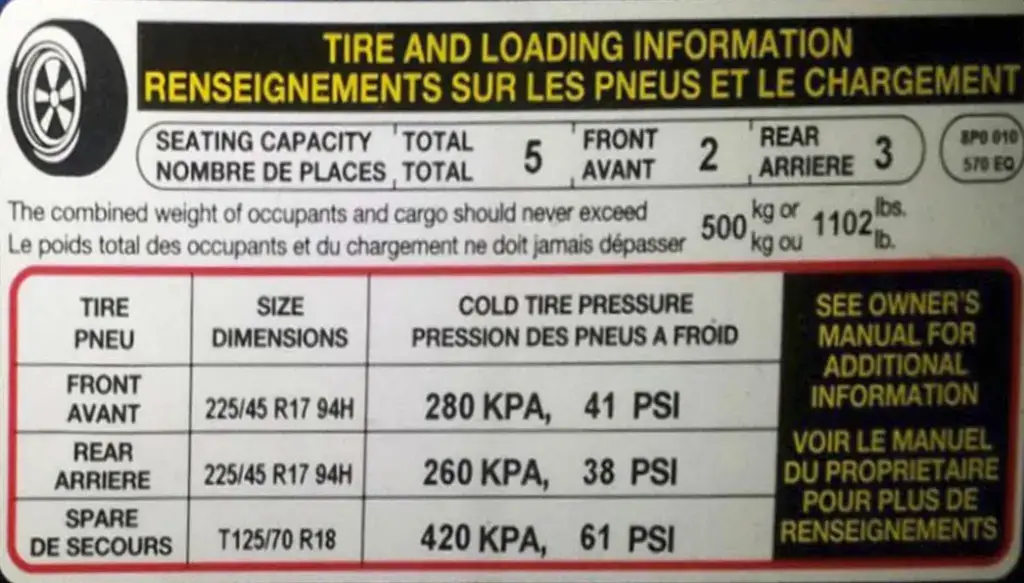What the maximum tire pressure on the sidewall means
Maximum tire pressure on the sidewall — what does it mean?
Every tire lists a maximum tire pressure on the sidewall. That pressure is the maximum amount of pressure allowed. It’s only to be used if you’re hauling the maximum load your vehicle is rated for. Once you remove that load, you should reduce tire pressure to the recommended pressure listed on the label in the driver’s door area.
The tires’ maximum pressure shown on the sidewall almost always exceeds the recommended pressure. It isn’t advisable to fill your tire to this pressure for everyday driving. At max PSI, your car does not handle as well, braking is impaired, and you could risk dangerous blowouts. Over-inflation can also cause the center of your tire’s tread to wear out prematurely and reduce the lifespan of your tires.
You can use the max pressure on a temporary basis if you are hauling especially heavy load or towing something.
The pressure listed on the sidewall is NOT the recommended pressure! The recommended pressure is listed on the vehicle’s tire placard or in the vehicle’s owner’s manual. The recommended pressure is also calculated when the tire is cold.
Don’t Make the Mistake of Over-Inflating Your Tires to the Maximum tire pressure listed on the sidewall
The recommended inflation pressures are different for every vehicle make, model, and year, based on factors like the vehicle’s weight, suspension calibration, and tire size. Using the sidewall maximum as your target inflation pressure goes against the engineers’ calculations for ideal ride quality, handling, tread life, and safety.
Over-inflating to the maximum pressure on the sidewall will reduce traction and Handling
When tires are over-inflated, they develop a smaller overall footprint contacting the road. This reduces the amount of rubber making contact with the pavement. Decreased contact means decreased grip and traction, especially in slippery conditions like rain or snow. Over-inflation also makes the tires stiffer, which can cause them to skip and bounce over road imperfections rather than smoothly following the contours. This deteriorates handling precision.
Accelerated Tire Wear
The reduced footprint from over-inflation also concentrates the vehicle’s weight on a smaller area of the tread. This dramatically increases wear rates in the areas contacting the pavement while preventing even treadwear across the entire tire surface. You’ll find yourself replacing tires far more frequently than with proper inflation pressures. The saving grace is that the excessive wear is typically isolated to the center tread ribs.
Harsher Ride Quality
Stiff, over-inflated tires transmit a lot more high-frequency vibration and impact harshness from the road directly into the vehicle’s cabin. What you gain is an uncomfortable, even punishing ride quality over all but the smoothest pavement. Excessive tire inflation pressure is the enemy of ride comfort and isolation from road imperfections. This uncomfortable experience is amplified in vehicles with firm suspension tuning and low-profile tires already prone to communicating more road information.
Increased Risk of Impact Damage
The stiffness of over-inflated tires also reduces their ability to deflect and absorb impacts from potholes and road hazards. This transfers more force into the wheels, suspension components, and vehicle body upon striking objects. Over time this can lead to excessive wear or potential failure of shock absorbers, springs, bushings and other hardware. The tire itself is more prone to sidewall damage, bulges and punctures when stiffened by excessive air pressure.
These sources will list appropriate pressures for the front, rear, and (if equipped) spare tires. These numbers account for the vehicle’s weight with passengers and cargo. Adjustments may be specified for heavier versus lighter load ratings.
©, 2021 Rick Muscoplat
Posted on by Rick Muscoplat

